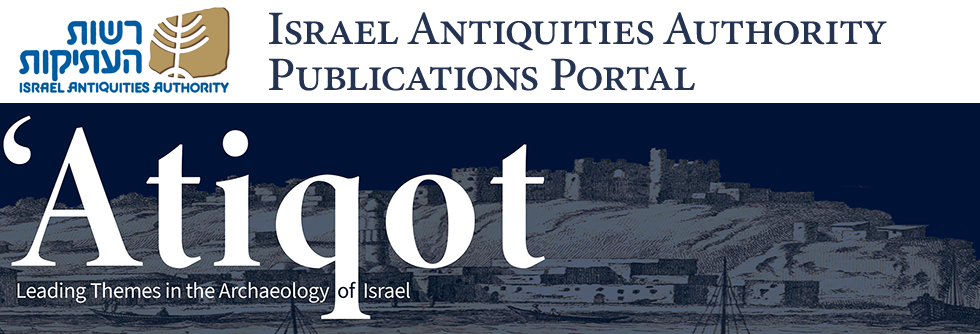[First posted 10/31/10, most recently updated 2 January 2026]

‘Atiqot is an open access, non-profit thematic journal dedicated to specific topics related to the archaeology of Israel. It is published by the Israel Antiquities Authority three times a year, online and in print. All content published in the journal is subject to double-blind peer-review and language editing. The printed volumes are available for purchase via the IAA website.
Current Volume: Volume 119 (2025) Archaeological Perspectives on Water Use and Management
Front Matter
Editorial Board and Zvi GreenhutThe Date and Function of the Horizontal Gutter-Like Water Channels along the Walls of the Herodian Temple Mount
Nahshon Szanton and Shlomit Weksler-BdolahRevisiting the ‘Aujah Aqueducts: New Insights and Discoveries
Yevgeny Aharonovich, Hananya Hizmi, Tal Orenshtein, and Haim ShkolnikThe Water Cisterns in the Roman-Period Jewish Town of Bet She‘arim
Danny Binshtok, Adi Erlich, and Tsvika TsukThe Circular Structure at ‘Ein al-Qastal: A Springhouse?
Jacob Sharvit and Ofra BarkaiThe Naḥal ‘Avedat Reservoirs: A Unique Road Site in the Negev Highlands
Tali Erickson-Gini and Ofer SionExploring the Wall Graffiti in the Raqafot Reservoir, Be’er Sheva‘
Davida Eisenberg-Degen and Deborah CvikelStrategic Water Management in the Fortified Monasteries of Western Samaria as a Tool for Controlling an Agricultural Region
Yair Elmakayes, David Ben-Shlomo, Naomi Hadad, and Amos FrumkinThe Water-Supply System to Ramla in the Early Islamic Period
Ron Toueg, Yuliya Gummeny, Oren Shmueli, and Omri DanzigerA Spring Tunnel, Aqueducts and Water-Powered Flour Mills along Naḥal Qeni: A History of Water Exploitation
Yotam TepperA Unique Historical Water Lifting System in Southern Palestine
Avraham (Avi) SassonMonumental Construction and Water Management at the Foot of the Temple Mount, Western Wall Tunnels Excavations, Jerusalem
Shlomit Weksler-BdolahThe Pottery from the Western Wall Tunnels, Jerusalem
Peretz ReuvenArchitectural Elements and a Statue Fragment from the Western Wall Tunnels, Jerusalem
Orit Peleg-BarkatCoins from the Western Wall Tunnels, Jerusalem
Yanniv David LevyRoman-Period Radiocarbon Chronology of the Great Causeway, Western Wall Tunnels, Jerusalem
Johanna Regev, Shlomit Weksler-Bdolah, Eugenia Mintz, Lior Regev, and Elisabetta BoarettoPetaḥ Tiqwa, Mulabbis: A Crusader-Period Water Reservoir and Finds form the Byzantine, Early Islamic and Ottoman Periods (with contributions by Lior Rauchberger, Nitzan Amitai-Priess, Amir Golani)
Elie Haddad and Ruth Smadar GabrieliGlass Finds from Excavations at Petaḥ Tiqwa, Mulabbis
Yael Gorin-Rosen
See the fill List of Open Access Journals in Ancient Studies









 Stumble It!
Stumble It!

No comments:
Post a Comment